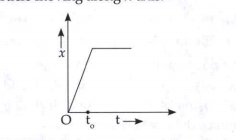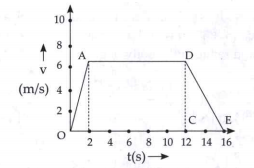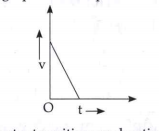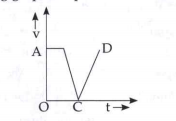Complete Solutions to EXERCISE of chapter MOTION IN A PLANE of Class 11 book with complete answers and questions
| Class 11 | PHYSICS |
| Chapter | MOTION IN A PLANE |
| CHETANA PUBLICATION | EXERCISE |
| Number Of Questions | 100 |
| Academic Year | 2023-24 |
A car travels at a speed of 50 `km//hr` for 15 minute and then 70 `km//hr` for next 45 minutes. What is the average speed of the car?
View SolutionA body travels from place A to place B with uniform velocity of 10 `m//s` and travels back from place B to place A with uniform velocity of 2m `m//s`. Calculate the average velocity of the body for the whole journey.
View SolutionSeparate the following in groups of scalars. and vectors velocity, speed, displacement, work done,force power, energy acceleration, electric charge, angular velocity.
View SolutionDefine average velocity and instantaneous velocity. When are they same?
View SolutionDifferentiate between
Uniform rectilinear motion and Non-Uniform rectilinear motion
View SolutionWhat is position -time graph ? Discuss the position time graph of an object (i) at rest (ii) in uniform motion. (iii) object performing oscillatory motion. (iv) object in non-uniform rectilinear motion.
View SolutionExplain the terms. (i) Acceleration (ii) average acceleration (iii) instantaneous acceleration
View SolutionExplain velocity time graph of a particle having Constant velocity (ii) uniform positive acceleration (iii) uniform negative acceleration (iv) non- uniform acceleration.
View SolutionA metro train runs from station A to B C. It takes 4 minutes in travelling from Station A to Station B. The train halts at station B for 20 s. Then it starts from station B and reaches Station C in next 3 minutes. At the start, the train accelerates for 10 s to reach the constant speed of 72 `km//hr`. The train moving at the constant speed is brought to rest in 10 sec. At next station. (i) Plot the velocity- time graph for the train travelling from the station A to B to C. (ii) Calculate the distance between the stations A, B and C.
View SolutionWhich physical quantity can be determined by the area under the velocity time `curves// graphs`?
View SolutionUsing velocity time graph, derive the equations of motion for uniform acceleration moving along a straight line.
View SolutionAn aeroplane has a run of 500 m to take off from runway. It starts from rest and moves with constant acceleration to cover the runway in 30 s. What is the velocity of the aeroplane at the take off?
View SolutionA car moving along a straight road with a speed of 120 `km//hr` is brought to rest by applying brakes. The car covers a distance of 100 m before it stops. Calculate (i) average retradation of the car. (ii) time taken by the car to come rest.
View SolutionA stone is released from the top of a tower 90m high. At the same instant a second stone is projected vertically upwards from the ground with a velocity of 30 `m//s`. When and where will the two stones meet?
View SolutionA body released from rest a certain height was observed to cover 78.4 m in the last two seconds before hitting the ground. Find the height from which it was realesed. `(g = 9.8 m//s^2)`
View SolutionDefine : Free fall
View SolutionGalileo's law of odd numbers : The distances traversed during equal intervals of time, by a body falling from rest, stand to one another in the same ratio as the odd numbers beginning with unity namely `1:3:5:7`.....Prove it.
View SolutionExplain 'Relative velocity'.
View SolutionTwo parallel rail tracks run north-south. Train A moves north with a speed of 54 km `hr^-1` aned train B moves south with a speed of 90 km `hr^-1`. What is the (i) velocity of B with respect to A ? (ii) velocity of ground with respect to A? (iii) velocity of a monkey running on the roof of 18 `km//hr` with respect to train A as observed by a man standing on the ground.
View SolutionThe position vector of a particle moving in XY plane at any instant of time is `x= 4t^2 hati + 3t^2hatj`. Find the instantenous speed.
View SolutionIf the motion of an object is described by x=f(t) write formulae for instantenous velocity and acceleration.
View SolutionThe position of an object moving along the x axis is given by `x = a + bt^2` where a = 8.5 and b= 2.5 m` s^2` and t is measured in second. What is the velociity at t=0 s and t= 2s? What is the average velocity between t= 2 s and t=4s?
View SolutionA train is moving east ward at 10 m `s^-1`. A waiter is walking eastward at 1.2 m `s^-1` and a fly is charging towards the north across the waiter's tray at 2 `m//s`. What is the velocity of the fly relative to the earth.
View SolutionDerive equations of motion for a particle moving in a plane and show that the motion can be resolved in two independent motions in mutually perpendicular directions.
View SolutionA train is moving east ward at 10 m `s^-1`. A waiter is walking eastward at 1.2 m `s^-1` and a fly is charging towards the north across the waiter's tray at 2 `m//s`. What is the velocity of the fly relative to the earth.
View SolutionDerive equations of motion for a particle moving in a plane and show that the motion can be resolved in two independent motions in mutually perpendicular directions.
View SolutionDefine the terms : (i) projectile (ii) Velocity of projection (iii) Angle of projection (iv) Trajectory of projectile.
View SolutionShow that the path of a projectile is a parabola.
View SolutionDefine (i) Times of ascent (III) Time of descent (iii) Time of flight. Deriver necessary expressions.
View SolutionDefine horizontal range. Derive the necessary expression for it.
View SolutionA projectile is thrown at an angle of `30^@` to the horizontal. What should be the range of initial velocity (u) so that its range will be betweeen 40m and 50m? Assume g= 10 m `s^-2`.
View SolutionA man throws a ball to maximum horizontal distance of 80 m. Calculate the maximum height reached.
View SolutionA particle is projected with speed of u at an angle `theta` to the horizontal on an inclined surface making an angle `ϕ (ϕ<θ)` to the horizontal. Find an expression for its along the inclined surface.
View SolutionFind a formula for maximum height attained by object
View SolutionA stone is thrown vertically upward with a velocity of 30 `m//s`. How high will it rise? After how much time will it return to ground ? [Take g = 10 `m//s^2]
View SolutionAt wich point of its trajectory does the projectile have minimum speed?
View SolutionShow that for a given velocity of projection, there are two angles of projection which give the same range of projectile.
View SolutionDerive the expression for trajectory of a particle projected horizontally with velocity u from height H.
View SolutionDefine the terms : (i) Uniform circular motion (ii)Radius vector (iii) period (iv) Angular speed (v) Centripetal acceleration (vi) Centripetal force.
View SolutionState the requirements for an object to perform uniform circular motion.
View SolutionFind the expression for the speed and angular speed of a particle performing uniform circular motion. State SI unit of angular speed.
View SolutionShow that the centripetal force on a particle undergoing uniform circular motion `-momega^2vecr`
View SolutionA particle moves in a circle with constant speed of 15 `m//s`. The radius of the circle is 2 m. Determine the centripetal acceleration of the particle.
View SolutionWhat is conical pendulum? Show that its time period is given by `2pi sqrtfrac(lcostheta)(g)`, where l is the length of the string, `theta` is the angle that the string makes with the vertical and g is the acceleration due to gravity.
View SolutionA car moves in a circle at the constant speed of `50m//s` and completes 1 revolution in 40s. Determine the magnitude of acceleration of the car.
View SolutionA string of length 0.5 m carries a bob at its end. If this is to be used as a conical pendulum of period `0.4pis`. Calculate the angle of inclination of the string with the vertical.
View SolutionAn object thrown from a moving bus is an example of:
View SolutionFor a particle having uniform circular motion, which is the following is constant?
View SolutionThe bob of a conical pendulum undergoes
View SolutionFor uniform acceleration in rectilinear motion which of the following is not correct?
View SolutionIf three particles A, B and C are having velocities `vecV_A`, `vecV_b` and `vecV_C` which of the following formula gives the relatives velocity of A with respect to B.
View SolutionThe actual distance travelled by the particle during its motion is called
View SolutionWhen a car moves towards east 50 m then towards south 50 m later on towards west 50m, finally towards north 50, the displacement of the car in magnitude is
View SolutionA body covers one-half of its journey at 40 m`s^-1` and the next half at 50 m `s^-1`. Its average velocity is.
View SolutionA bus travel its onward journey with a constant speed of `30km//hr` and its return journey with a constant speed of `60km//hr`.the average speed for its entire journey is
A. 90 k m / h r
B. 45 k m / h r
C. 40 k m / h r
D. 15 k m / h r
View SolutionA particle oscillates along a straight line 1m long, if it completes one oscillation in 0.1s, then the distance covered by it and its average speed in one oscillation is,
A. 1m, 20 m / s
B. 2m, 20 m / s
C. 2m, 15 m / s
D. 1m, 15 m / s
View SolutionThe position of an object movinfg along X-axis is given by `x = a + bt^2` where a = 8.5 m and b = 2.5 m and t is measured in second. If the object starts from t = 0, the velocity at t = 2s is
View SolutionA car accelerates on a straight road from rest to a speed of 180 `km//hr` in 25 second. Assuming Unifrom acceleration of the car out, the distance covered in this is
View SolutionA body has initial velocity of 3 `m//s` and has an acceleration of 2 `m//s^2`. The distance travelled by it in 5 s and its velocity is
View SolutionAn electron travelling with a speed of `5 xx 10^3`m/s passes through an electric field with an acceleration of `10^12 ms^-2`. How long will it take for electron to double its speed?
View SolutionA stone is thrown vertically upwards with initial velocity of 14 m `s^-1`. The maximum height it will reach is `[g = 9.8 m s^-2]`
View SolutionA swimmer's speed in the direction of flow of rivers is 16 km `h^-1`. The swimmer's speed in still water and the velocity of flow of the river respectively are.
View SolutionFigures shows the displacement-time graph of a particle moving along x-axis.

View SolutionArea under the curved of velocity-time graph of a particle moving with constant velocity is
View SolutionThe v-t graph of an athelets is shown below. The distance travelled by him between t=0 and t=12 s is

View SolutionThe v-t graph below represents

View SolutionThe velocity-time graph of a body is shown in the following graph. At point C
A. the force acting on the body is zero
B. only gravitational force is present
C. the force opposes the motion of the body
D. the force is maximum

View SolutionThe two dimensional motion of a body in which a vertical motion with constant acceleration (g) and a horizontal motion with constant velocity acts, such a motion is
View SolutionWhic of the following is NOT an example of a projectile?
View SolutionIn a projectile motion, the velocity vector of the projectile is
View SolutionThe trajectory of particle is symmetrical about the perpendicular drawn form the highest point on x-axis, if the particle performs projectile motion in xy plane.This is due to
View SolutionA shell is fired at an angle of `30^@` to the horizontal with velocity 196 `m//s`. The time of flight is
View SolutionA projectile can have the same range R for two angles of projection. If `t_1` and `t_2` are the times of flight in the two cases, then the product of the two time of flight is proportional to
A. `R^2`
B. `frac(1)(R^2)`
C. `frac(1)(R)`
D. `R`
View SolutionWhen a body is projected vertically up from the ground, its velocity is reduced to `(frac(1)(3))^(rd)` of its initial value at height y above the ground . The maximum height reached by the body is
View SolutionA body is projected with a vertical velocity of 30 `m//s` at an angle of `30^@` with the horizontal, the maximum height and horizontal range are respectively
View SolutionThe angle between velocity and acceleration of a particles describing uniform circularmotion is.
View SolutionA particles moves with a uniform speed v and time period T in a circular path of radius r. If the speed of the particle is doubled, its new time periods is
View SolutionIn uniform circular motion, the centripetal acceleration is
View SolutionAn aeroplane is flying with a uniform speed of 150km / h along the circumference of a circle. The change in its velocity in half the revolution (in km / h) is:
A. 150
B. 100
C. 200
D. 300
View SolutionThe ratio of angular speed of a second hand to the hour of a watch is
View SolutionWhat is approximately the centripetal acceleration (in units of acceleration due to gravity on earth `g = 10 m s^-2`) of an aircraft flying at a speed of 400 m`s^-1` through a circular are of radius 0.6 km.
View SolutionTwo cars of masses `m_1` and `m_2` are moving in circles of radii `r_1` and `r_2` respectively. Their speeds are such that they make complete circles in the same time t. The ratio of their centripetal acceleration
View SolutionA body moves in a circle covers equal distance in equal intervals to time. Which of the following remains constant?
View SolutionThe acceleration of an object moving in a circle of radius R with uniform speed v is
View SolutionA particle is moving with a constant speed 'v' in a circle what is the magnitude of average velocity after half rotation ?
View SolutionThe earth moves round the sun in a near circular orbit of radius `1.5 xx 10^11`m. Its centripetal acceleration is
View SolutionWhich one of the folowing statements is not correct in uniform circular motion?
View SolutionA body moving along a circular path of radius r with velocity V, has centripetal acceleration 'a'. If its velocity is made equal to 2V, then its centripetal acceleration is.
View SolutionA body of mass 2 kg is rotating with angular speed `2pi` rad `s^-1` in a circular path of radius 1m. The centripetal force acting on the body is.
View SolutionParabola is the locus of the points which are equidistance form
View SolutionWhat does the slope of X-t graph at any point give ?
View SolutionWhat does the slope of X-t graph at any point give ?
View SolutionWhat does the slope of X-t graph at any point give ?
View SolutionWhat does the slope of X-t graph at any point give ?
View SolutionWhen a body moves along a straight line, it is called
A. Rectilinear motion
B. Circular motion
C. Projectile motion
D. Oscillatory motion
View SolutionWhen a body moves along a straight line, it is called
A. Rectilinear motion
B. Circular motion
C. Projectile motion
D. Oscillatory motion
View SolutionWhen a body moves along a straight line, it is called
A. Rectilinear motion
B. Circular motion
C. Projectile motion
D. Oscillatory motion
View SolutionWhen a body moves along a straight line, it is called
A. Rectilinear motion
B. Circular motion
C. Projectile motion
D. Oscillatory motion
View SolutionA body is thrown with velocity of 49 m `s^-1` at an angle of `30^@` with the horizontal, the time required to attained maximum height is ,
A. 5 s
B. 4 s
C. 3 s
D. 2 s
View SolutionA body is thrown with velocity of 49 m `s^-1` at an angle of `45^@` with the horizontal, the time required to attained maximum height is ,
A. 5.05 s
B. 6.06 s
C. 7.07 s
D. 8.08 s
View Solution
EXERCISE questions and complete solutions for chapter MOTION IN A PLANE of CHETANA PHYSICS (MARATHI ENGLISH) of Class 11